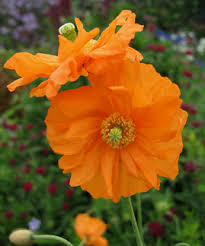Morocco is a country on the coast of North Africa. It mostly has a Mediterranean climate with an awe-inspiring abundance of flora. There are an estimated 5,000 different species of plants in Morocco, and many of them are endemic to the region. Going on a nature walk through any part of the country will give you an entertaining view of plants both big and small.



Morocco with its privileged geographical position, unique mountain conditions and very characteristic climates has resulted in it having an attractive and fascinating flora. The richness and diversity of the flora show the country to be a veritable reservoir of biodiversity situated at floristic crossroads. Sauvage (1994) has indicated that Morocco is one of those western Mediterranean countries where the flora is the most rich and the most varied and that this richness is easily explained by the variety of Mediterranean climates from the Sahara to the moist, the wriest range Iran in the East. Sauvage noted that an explanation was also the general location of Morocco with two lengthy seacoasts, one open along all its length (c. 2800 km) to the influence of the Atlantic ocean, the other to the Mediterranean influence.



The high summits (several of which pass 4000 m) of the Middle and High Atlas over give rise to the high mountain vegetation types.
There are 4979 accepted taxa in the Moroccan flora, of these 1282 are recognise as subspecies. This significant number of vascular plants gives Morocco a privileged position amongst the countries bordering the Mediterranean Sea, coming after Turkey, Italy, Greece and Spain.
There are nine important families with over 100 species containing almost 60% of the flora. These families are in order of importance: Asteraceae (500 spp.), Fabaceae (400 spp.), Poaceae (300 spp.), Caryophyllaceae (217 spp.), Lamiaceae (210 spp.), Cruciferae (Brassicaceae) (185 spp.), Apiaceae (160 spp.), Scrophulariaceae (130 spp.), Liliaceae (110 spp.).
The others families also important, but with only 50-60 species are: The Boraginaceae, Chenopodiaceae, Cistaceae, Cyperaceae and Ranunculaceae. Some families contain less than five Species families (eg. Oxalidaceae), and others are monotypic (eg. Berberidaceae, Coriariaceae, Adoxaceae and Droseraceae). The genus Silene is by far the richest in the Moroccan flora with 69 species, followed by the genera Centaurea, Ononis, Teucrium, Euphorbia, Trifolium and Linaria where the number of species varies between 40 and 50, then the genera Orobanche, Juncus, Helianthemum, Erodium, Ranunculus, Lotus, Vicia and Carex each containing 30 to 35 species.
To this native flora can be added a multitude of exotic species introduced for economic ends as Pinus spp., Ornamentals as Hibiscus spp., as well as several adventives and ruderals. It is important to note in this Saharian provinces are still underexplored. Further methodical exploration will reveal many novelties.
morocco culture,moroccan food,morocco food,moroccan cuisine,morocco beaches,moroccan meal,beaches in morocco,moroccan culture,hercules cave,hercules cave morocco


Morocco with its privileged geographical position, unique mountain conditions and very characteristic climates has resulted in it having an attractive and fascinating flora. The richness and diversity of the flora show the country to be a veritable reservoir of biodiversity situated at floristic crossroads. Sauvage (1994) has indicated that Morocco is one of those western Mediterranean countries where the flora is the most rich and the most varied and that this richness is easily explained by the variety of Mediterranean climates from the Sahara to the moist, the wriest range Iran in the East. Sauvage noted that an explanation was also the general location of Morocco with two lengthy seacoasts, one open along all its length (c. 2800 km) to the influence of the Atlantic ocean, the other to the Mediterranean influence.



The high summits (several of which pass 4000 m) of the Middle and High Atlas over give rise to the high mountain vegetation types.
There are 4979 accepted taxa in the Moroccan flora, of these 1282 are recognise as subspecies. This significant number of vascular plants gives Morocco a privileged position amongst the countries bordering the Mediterranean Sea, coming after Turkey, Italy, Greece and Spain.
There are nine important families with over 100 species containing almost 60% of the flora. These families are in order of importance: Asteraceae (500 spp.), Fabaceae (400 spp.), Poaceae (300 spp.), Caryophyllaceae (217 spp.), Lamiaceae (210 spp.), Cruciferae (Brassicaceae) (185 spp.), Apiaceae (160 spp.), Scrophulariaceae (130 spp.), Liliaceae (110 spp.).
The others families also important, but with only 50-60 species are: The Boraginaceae, Chenopodiaceae, Cistaceae, Cyperaceae and Ranunculaceae. Some families contain less than five Species families (eg. Oxalidaceae), and others are monotypic (eg. Berberidaceae, Coriariaceae, Adoxaceae and Droseraceae). The genus Silene is by far the richest in the Moroccan flora with 69 species, followed by the genera Centaurea, Ononis, Teucrium, Euphorbia, Trifolium and Linaria where the number of species varies between 40 and 50, then the genera Orobanche, Juncus, Helianthemum, Erodium, Ranunculus, Lotus, Vicia and Carex each containing 30 to 35 species.
To this native flora can be added a multitude of exotic species introduced for economic ends as Pinus spp., Ornamentals as Hibiscus spp., as well as several adventives and ruderals. It is important to note in this Saharian provinces are still underexplored. Further methodical exploration will reveal many novelties.
morocco culture,moroccan food,morocco food,moroccan cuisine,morocco beaches,moroccan meal,beaches in morocco,moroccan culture,hercules cave,hercules cave morocco

No comments:
Post a Comment